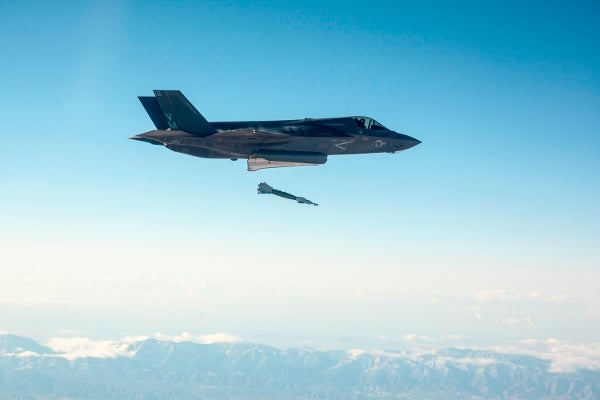
The US Marine Corps’ (USMC) Lockheed Martin-built F-35B Lightning II Joint Strike Fighter (JSF) aircraft has successfully completed its first guided weapon delivery against a ground target.
During the testing, the F-35B short take-off and vertical landing (STOVL) fighter aircraft, piloted by Marine Corps major Richard Rusnok, used electro-optical targeting system (EOTS) to identify, track and designate the target, and launched a Guided Bomb Unit-12 (GBU-12) Paveway II laser-guided weapon.
Following the launch from F-35’s internal weapons bay from 25,000ft, the 500lb GBU-12 weapon successfully destroyed fixed ground tank test target placed at the Edwards Air Force Base Precision Impact Range Area.
The EOTS sensor features forward-looking infrared, infrared search and track, and laser designator to enhance capability for F-35 pilots.
Rusnok said guided weapons delivery test of a GBU-12 marks a step ahead in the development of F-35 programme.
"This guided weapons delivery test of a GBU-12 marks the first time the F-35 truly became a weapon system," Rusnok said.
The F-35 fifth generation fighter features advanced stealth with fighter speed and agility, fully fused sensor information, network-enabled operations and advanced sustainment.
Powered by a single Pratt & Whitney F135 afterburner turbofan engine, F-35B can cruise at a maximum speed of 1,960km/h and has a range of 1,667km.
The single-engine F-35B aircraft will replace the F/A-18 Hornet and AV-8B Harrier II fighter aircraft currently in service with the USMC.
In addition to replacing the Marine Corps’ AV-8B Harrier and F-18 Hornet aircraft, the other JSF variants will replace the air force’s existing F-16 Fighting Falcon and A-10 Thunderbolt II fleet, as well as the McDonnell Douglas F/A-18 Hornet aircraft for the navy.
Image: A USMC’s F-35B aircraft launches GBU-12 weapon. Photo: courtesy of Lockheed Martin.









